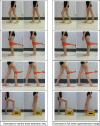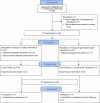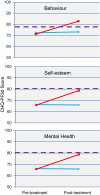Exercise in children with joint hypermobility syndrome and knee pain: a randomised controlled trial comparing exercise into hypermobile versus neutral knee extension
- PMID: 23941143
- PMCID: PMC3751568
- DOI: 10.1186/1546-0096-11-30
Exercise in children with joint hypermobility syndrome and knee pain: a randomised controlled trial comparing exercise into hypermobile versus neutral knee extension
Abstract
Background: Knee pain in children with Joint Hypermobility Syndrome (JHS) is traditionally managed with exercise, however the supporting evidence for this is scarce. No trial has previously examined whether exercising to neutral or into the hypermobile range affects outcomes. This study aimed to (i) determine if a physiotherapist-prescribed exercise programme focused on knee joint strength and control is effective in reducing knee pain in children with JHS compared to no treatment, and (ii) whether the range in which these exercises are performed affects outcomes.
Methods: A prospective, parallel-group, randomised controlled trial conducted in a tertiary hospital in Sydney, Australia compared an 8 week exercise programme performed into either the full hypermobile range or only to neutral knee extension, following a minimum 2 week baseline period without treatment. Randomisation was computer-generated, with allocation concealed by sequentially numbered opaque sealed envelopes. Knee pain was the primary outcome. Quality of life, thigh muscle strength, and function were also measured at (i) initial assessment, (ii) following the baseline period and (iii) post treatment. Assessors were blinded to the participants' treatment allocation and participants blinded to the difference in the treatments.
Results: Children with JHS and knee pain (n=26) aged 7-16 years were randomly assigned to the hypermobile (n=12) or neutral (n=14) treatment group. Significant improvements in child-reported maximal knee pain were found following treatment, regardless of group allocation with a mean 14.5 mm reduction on the visual analogue scale (95% CI 5.2 - 23.8 mm, p=0.003). Significant differences between treatment groups were noted for parent-reported overall psychosocial health (p=0.009), specifically self-esteem (p=0.034), mental health (p=0.001) and behaviour (p=0.019), in favour of exercising into the hypermobile range (n=11) compared to neutral only (n=14). Conversely, parent-reported overall physical health significantly favoured exercising only to neutral (p=0.037). No other differences were found between groups and no adverse events occurred.
Conclusions: Parents perceive improved child psychosocial health when children exercise into the hypermobile range, while exercising to neutral only is perceived to favour the child's physical health. A physiotherapist prescribed, supervised, individualised and progressed exercise programme effectively reduces knee pain in children with JHS.
Trial registration: Australia & New Zealand Clinical Trials Registry; ACTRN12606000109505.
Figures



Similar articles
-
A randomised controlled trial of heavy shoulder strengthening exercise in patients with hypermobility spectrum disorder or hypermobile Ehlers-Danlos syndrome and long-lasting shoulder complaints: study protocol for the Shoulder-MOBILEX study.Trials. 2020 Dec 1;21(1):992. doi: 10.1186/s13063-020-04892-0. Trials. 2020. PMID: 33261635 Free PMC article.
-
Proprioceptive acuity into knee hypermobile range in children with joint hypermobility syndrome.Pediatr Rheumatol Online J. 2014 Sep 8;12:40. doi: 10.1186/1546-0096-12-40. eCollection 2014. Pediatr Rheumatol Online J. 2014. PMID: 25278815 Free PMC article.
-
The feasibility of a randomised controlled trial of physiotherapy for adults with joint hypermobility syndrome.Health Technol Assess. 2016 Jun;20(47):1-264. doi: 10.3310/hta20470. Health Technol Assess. 2016. PMID: 27365226 Free PMC article. Clinical Trial.
-
Physical exercise training interventions for children and young adults during and after treatment for childhood cancer.Cochrane Database Syst Rev. 2013 Apr 30;(4):CD008796. doi: 10.1002/14651858.CD008796.pub2. Cochrane Database Syst Rev. 2013. Update in: Cochrane Database Syst Rev. 2016 Mar 31;3:CD008796. doi: 10.1002/14651858.CD008796.pub3. PMID: 23633361 Updated. Review.
-
Supplementation of a home-based exercise programme with a class-based programme for people with osteoarthritis of the knees: a randomised controlled trial and health economic analysis.Health Technol Assess. 2004 Nov;8(46):iii-iv, 1-61. doi: 10.3310/hta8460. Health Technol Assess. 2004. PMID: 15527668 Review.
Cited by
-
Pain Symptomatology and Management in Pediatric Ehlers-Danlos Syndrome: A Review.Children (Basel). 2020 Sep 21;7(9):146. doi: 10.3390/children7090146. Children (Basel). 2020. PMID: 32967103 Free PMC article. Review.
-
Physical and mechanical therapies for lower limb symptoms in children with Hypermobility Spectrum Disorder and Hypermobile Ehlers-Danlos Syndrome: a systematic review.J Foot Ankle Res. 2018 Nov 7;11:59. doi: 10.1186/s13047-018-0302-1. eCollection 2018. J Foot Ankle Res. 2018. PMID: 30455744 Free PMC article.
-
The Impact of Podiatric Intervention on the Quality of Life and Pain in Children and Adolescents with Hypermobility.Int J Environ Res Public Health. 2023 Aug 22;20(17):6623. doi: 10.3390/ijerph20176623. Int J Environ Res Public Health. 2023. PMID: 37681763 Free PMC article.
-
The effectiveness of conservative interventions for the management of syndromic hypermobility: a systematic literature review.Clin Rheumatol. 2021 Mar;40(3):1113-1129. doi: 10.1007/s10067-020-05284-0. Epub 2020 Jul 17. Clin Rheumatol. 2021. PMID: 32681365 Free PMC article.
-
Multidisciplinary Treatment for Hypermobile Adolescents with Chronic Musculoskeletal Pain.J Rehabil Med Clin Commun. 2020 May 8;3:1000033. doi: 10.2340/20030711-1000033. eCollection 2020. J Rehabil Med Clin Commun. 2020. PMID: 33884135 Free PMC article.
References
-
- El-Garf AK, Mahmoud GA, Mahgoub EH. Hypermobility among Egyptian children: prevalence and features. J Rheumatol. 1998;25:1003–1005. - PubMed
LinkOut - more resources
Full Text Sources
Other Literature Sources

